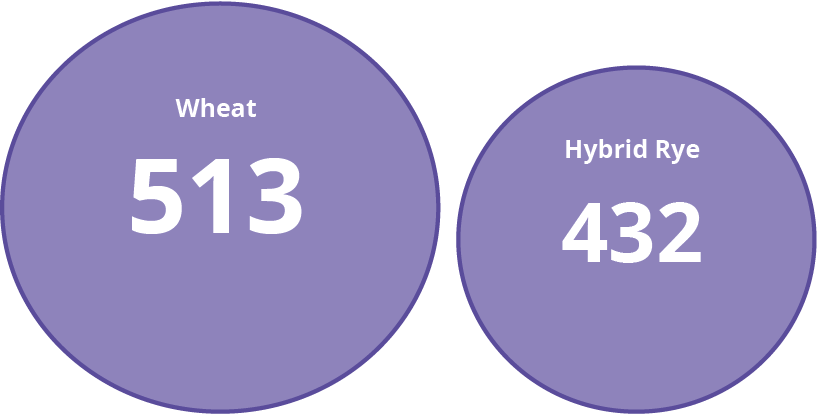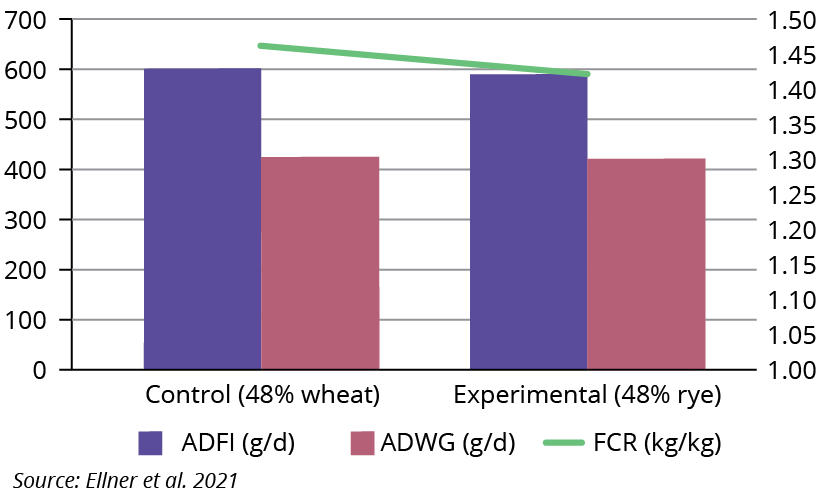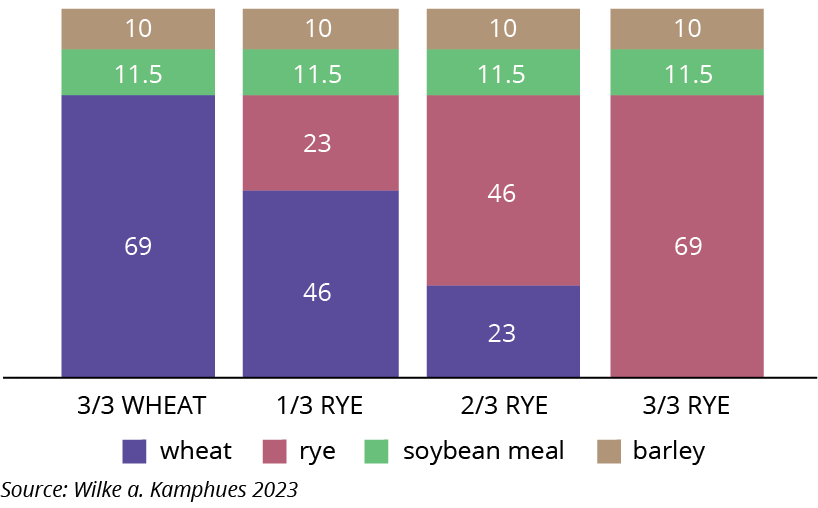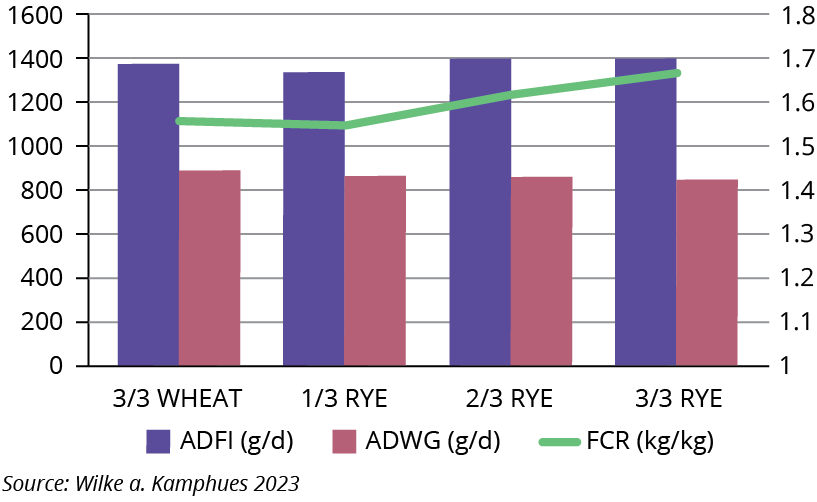Dr med. vet. Volker Wilke, Institute for Animal Nutrition, University of Veterinary Medicine Hanover, Foundation
The quest for sustainable and efficient livestock production has led to exploring alternative feed ingredients that provide essential nutrients while minimising environmental impact. In recent years, rye has gained attention as a potential feed ingredient for fattening pigs due to its nutritional profile, environmental benefits, and cost-effectiveness.
Today, the choice of cereal varieties in pig feed is not just about maximising energy and protein yield per acre but about solutions adapted to current conditions. These conditions are characterised by climate change (heat- and drought-tolerant crops), environmental impacts (costs for fertilisers and pesticides), and advances in plant breeding (yields of new varieties).
Figure 1 – Impact on Climate Change (kg CO2 eq / ton product) of wheat and hybrid rye (KWS branded Data, GFLI 2023).

Global focus on sustainability
As the global focus on sustainable agriculture intensifies, hybrid rye offers several environmental benefits in pig feed. Rye is a hardy crop that requires fewer agrochemical inputs and thrives in colder climates and poorer soils, promoting soil health and reducing erosion risk. Additionally, rye can be part of cover cropping strategies, reducing nutrient runoff and improving overall farm sustainability. Given the climate change context and the environmental impact of cereal cultivation, there are many arguments for rye, including efficient use of limited resources like water and phosphorus, and a relatively low carbon footprint (Figure 1). These factors could play a larger role and create market opportunities in the future, especially if feed- and foodstuffs and are labelled with a “CO2 footprint.”
Many advantages of rye
Wheat and rye differ in their starch and crude fibre content. Wheat has 17-33% more crude protein than rye, but rye offers a lysine-rich amino acid profile. This can be advantageous for diets of older fattening pigs, allowing lower protein content without performance loss by supplementing with individual amino acids.
Rye is also an excellent source of fibre, especially soluble fibre, which benefits pig gut health. Increased fermentation leads to higher levels of lactic acid and short-chain fatty acids in the digestive tract, positively affecting animal health.
 Is rye an alternative to maize and triticale for whole crop?
Is rye an alternative to maize and triticale for whole crop?
Despite many advantages of using rye in pig feed, several key factors must be considered. High acceptance and feed intake are crucial, leading to favourable daily gains and a low feed-conversion ratio. Recent studies on rye use in fattening pigs suggest it can be introduced early. Rye can be used in weaner piglet diets, with early adaptation benefiting later fattening periods. However, only small amounts should be used for very young animals. A German study found that replacing 48% of wheat with rye had no negative effects (Figure 2).
Figure 2 – Performance of weaner piglets.

Positive results from several studies
A study from Illinois showed that up to 60% of corn can be replaced with rye in the initial five weeks post-weaning. Aside from a slightly increased feed-conversion ratio, no negative effects on weight gain and feed intake were observed.
In our own studies at the Institute for Animal Nutrition, young fattening pigs (16 – 40 kg) were fed diets containing increasing proportions of rye, with similar results (Figure 3 and 4).
Figure 3 – Compound feeds: Main ingredients.

As seen from these data, higher levels of hybrid rye in the diet did not affect feed intake and gains in young animals. However, with 46% rye in the diet, the feed conversion ratio increased in these young pigs.
In Poland, studies on the use of rye in pig feed are also on the rise. A recent study examined not only animal performance but also potential effects on carcass condition (Table 1). Pigs were fattened from 29 kg to about 110 kg, with diets containing 20%, 40%, and 60% rye compared to a standard barley and wheat-based diet. Soybean meal was used as the protein source.
Regarding animal performance, no negative effects were found with increasing amounts of rye in the diets. The results also showed no losses in carcass quality due to the higher rye content.
Backfat thickness, carcass lean meat, and major cuts content were unaffected in the group fed hybrid rye-based diets compared to the control group fed barley and wheat. Additionally, no changes were observed in the physical meat characteristics, basic chemical composition, cholesterol content, or sensory characteristics of the animals fed rye. On the contrary, more favourable values for PUFA n-3 were found, leading to a better PUFA n-6 to n-3 ratio.
Figure 4 – Performance of young fattening pigs.

Practical conclusions
The use of rye offers advantages in pig feeding. For very young pigs, moderate amounts should be used to avoid an increase in feed requirements. However, in the grower and finisher phases, significantly larger quantities can be used while achieving favourable gains (Table 2).















